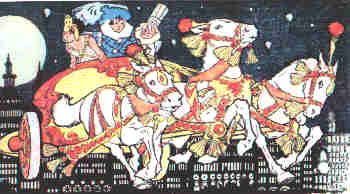| … pioneers. Little Nemo in Slumberland is among the first to be remembered for its outstanding quality. Even today, it is regarded as one of the high points in the history of comics.
Winsor McCay worked as a sign painter, vaudeville performer and freelance cartoonist in Cincinnati, Ohio, during the late 19th century and the first couple of years of the 20th. In 1903, when he was probably in his mid-30s (the exact date of his birth is unknown), he drew his first color Sunday feature, Tales of the Jungle Imps, for the Cincinnati Enquirer. McCay provided illustrations for poems and stories written by "Felix Fiddle" (a pseudonym of editor George Chester). It was probably Jungle Imps that brought him to the attention of newspaper publisher James Gordon Bennet, and led to his move to New York later that year.
In 1905, while working at Bennett's New York Herald on such features as Hungry Henrietta and Little Sammy Sneeze, McCay started his two most famous comic strips, both of which were about nocturnal adventures. Dreams of the Rarebit Fiend had no continuing characters, only a continuing motif — nightmares brought on by indigestion. And Little Nemo in Slumberland, which started on October 15 of that year, was about a little boy (whose name, by the way, is Latin for "nobody") and his excursions in a fabulously surreal fantasy kingdom. Each week, Nemo's adventures would be interrupted when, in the last panel of the page, he would wake up.
Little Nemo quickly transcended his newspaper origins. The character was heavily merchandised as early as 1906, appearing in a series of McCay-drawn postcards, as well as books, games, and children's clothing. In 1908, Victor Herbert (author of Babes in Toyland) wrote a play about Nemo, which was performed on Broadway. In 1911, McCay, who in addition to his accomplishments as a newspaper cartoonist, was also a pioneer of animation (his Gertie the Dinosaur was perhaps animation's first success), created an animated version of the character in 1911, making him the first comics character adapted into that medium. He also inspired a minor genre of whimsical fantasy starring kids, including Billy Bounce, Bobby Make-Believe and Nibsy the Newsboy in Funny Fairyland.
In 1911, McCay was lured away from Bennet's paper by William Randolph Hearst. The "Nemo" feature came to an end on April 23 of that year, only to be reborn on the 30th in the Hearst papers, under the title In the Land of Wonderful Dreams. It continued under that title until 1914, when McCay went back to work for Bennet. The strip was revived in the 1920s, but ran only a couple of years before ending once and for all in 1927. McCay died in 1934.
Robert McCay, the cartoonist's son (and original model for Nemo) tried twice to resurrect the strip, once in the late 1930s and again a decade later. The second attempt ended in 1947, and that was the end of Little Nemo in Slumberland as a newspaper feature.
But the strip was far from forgotten! In 1966, it was part of an exhibit of McCay's work at New York's Metropolitan Museum of Art, one of the few such exhibits ever devoted to a comic strip cartoonist. Maurice Sendak, the highly-acclaimed children's author and illustrator, cited McCay as a major influence on his own work. Publisher Woody Gelman reprinted much of the strip's run in the 1940s, and even more in the '70s. In 1995, in company with Toonerville Folks, Brenda Starr, Terry & the Pirates and other "Comic Strip Classics", it appeared on a U.S. postage stamp. Between 1989 and 1993, Fantagraphics Books reprinted both of the early runs of the strip — Bennet and Hearst — in a six-volume set which stands, today, as the strip's definitive edition.
Even today, nearly a century after its first appearance, Little Nemo in Slumberland has seldom been equalled, and perhaps never surpassed, as an example of the sheer beauty of which the comics form is capable.
— DDM
BACK to Don Markstein's Toonopedia™ Home Page
Today in Toons: Every day's an anniversary!
| |
Purchase Little Nemo Books Online
|
